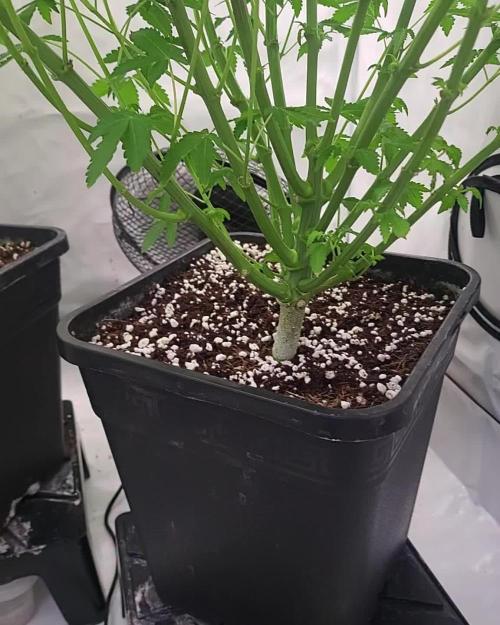The Grow Awards 2026 🏆 

































Likes
Comments
Share


@Momentum
Follow
I'm growin' on,
and i'm prepared to gorwin' alone. 🎺
Sehr schöne Pflanze, hat sich quasi verdoppelt zum letzten Update. Macht einen guten Eindruck.
Likes
21
Share


@LittleBigTrees
Follow
I started Flushing two plants as there nearing the end of there days. I'll start Flushing the others this week apart from the kalimist indica pheno as it started flowering 3 or so weeks after the others even though they were all forced together. (alkward bugger)
Some of the plants are showing red /purple colours a little bit 👍
Likes
33
Share


@Viridios
Follow
Very excited..plants are looking super healthy, streatching nicely. These genetics are sutch a pleasure to grow. The next couple weeks are gona be epic..😁😁.
Likes
15
Share


@ElegantBuds
Follow
Bakers delight had a nice cookies smell all the way. A nice layer of trichomes and hard compact buds. A true beauty to the eyes.
Processing
Likes
6
Share


@Frosty905budz
Follow
Day 62 both Gorilla glue#4 and sour kush
By Native seed Company looking ready to me ..
Completing week 2 of flushing will harvest tomorrow.. Cant wait
Likes
8
Share


@Mo_Powers
Follow
the weather is just wonderful at the moment. i'm happy to be growing them so early in the year. they took to the topping really well, and they also coped well with the breakage last week and have healed.
Likes
Comments
Share


@Kider196nyc
Follow
ac infinity germination dome with heat mat and led lights. Seeds planted into solo cups
Likes
5
Share


@DaisyNabis
Follow
en espectáculo a la vista mis bellas, ya dan señales que el otoño llego y están próximas a su cosecha
Likes
3
Share


@Kinglui77
Follow
Because of the extrem Defolitation/Schwazzing, which was more or less necessary regarding Humidtiy levels of of over 95% around evening night and morning. Even though I also did it for trying out how the Plants react. They mainly stopped growing Bud for 3-4 Days and the leaves of the Bud Sides got a bit Bigger. Also I had problems with NutBurn and Heat Burn, Nutburn because of my not constantly watered Pots which, I guess, ended up beeing a really salty and nutrient soaked(from the soil) substrate because they are reused Filters for Water out of clay. As well in midday it gets really hot and we are more than 3500ft over the sea level.
And why I grow in Clay Filters ? Just to try, in my opinion already not recommendable even though it keeps the Soil a bit cooler..
Likes
5
Share


@Skinnytalls420
Follow
Day 1-12/12/21 seed is in water for 24hours! Day 2-13/12/21 seed has been placed on paper towel! Day 4-15/12/21 seed is in soil and tent!!! Day 6-17/12/21 seed has popped out the soil !!!!
Likes
5
Share


@beer420
Follow
Were getting there!
Plants looking beautiful and swelling up.
Two questions below!
Thanks for reading and happy growing.
Likes
Comments
Share


@BlumenBot
Follow
I'll be doing a cleanup sometime this week, the canopy is nearly as wide as the pot, I'm hoping to flip to flower in the next week or 2
Likes
7
Share


@Kevs_Best
Follow
DE
In der dritten Blütewoche zeigt der erste Last Dance-Phänotyp weiterhin kräftigen Stretch und wird immer dichter und buschiger. Die Hauptcolas formen sich sehr stark aus, die Blütenansätze nehmen schnell an Volumen zu. Sein Geruch wird immer intensiver – sehr dank und funky, mit einer tiefen gassigen Basis.
Der zweite Phänotyp bleibt kompakter, verzweigt sich aber gleichmäßig und zeigt ein interessantes, natürliches LST am unteren Hauptstamm. Die Bud-Sites entwickeln sich sichtbar, und der Duft geht klar in eine süßere, fruchtig-cocktailartige Richtung.
Insgesamt eine sehr produktive dritte Blütewoche – beide Pflanzen zeigen kräftige Blütenentwicklung, stabile Gesundheit und zunehmend komplexe Terpenprofile.
EN
In the third week of flowering, the first Last Dance phenotype continues to stretch strongly, becoming denser and bushier. The main colas are shaping up impressively, with flower sites gaining volume fast. Its aroma is getting very intense – dank and funky, with a deep gassy backbone.
The second phenotype remains more compact but branches evenly and shows an interesting natural LST at the lower main stem. Bud sites are visibly expanding, and its scent leans clearly towards a sweeter, fruity cocktail-like profile.
Overall, a very productive third week of flowering – both plants show vigorous bud development, strong health, and increasingly complex terpene expressions.
Likes
29
Share


@GrownwithLED
Follow
During week 12 the plants are in their 5th week of flowering since the switch to 12/12 hours of light/darkness. All plants develop nice flower crowns now and the top-buds start to get encrusted with trichomes. Especially the MAC from Tropical Trees seeds from Hawaii has already an impressive layer of trichomes on top. All 12 plants have a nice healthy green color, which shows the BIO NOVA nutrients work GREAT! 💪😎 My two SANlight EVO4-120 LEDs are doing an EXCELLENT job and are running on 100% power now (=3 GREEN lights on the dimmer ON). This cycle is going AWESOME until now and I cant wait for the buds to get bigger...
Likes
5
Share


@The420Century
Follow
She's ready to get flushed.
I've put her in my second tent to leave her in total darkness for 2 days before I'll hang her to dry. This helps the plant to break down the chlorophyll.
Likes
7
Share


@Grisly
Follow
Harvest 2024
Total Hash: 102g
Total Kief: 95g
Total Flower: 3868g/138oz/8.6lb
Total Yield: 4065g/145oz/9lb/4kilo
———-/-////////—vs———-/////————/
Sugar Diesel #1: 117g
Sugar Diesel #2: 313g
White widow Clone: 14g
Dual OG:
112g
LA Affie North Field: 248g
Granddaddy Purple N: 63g
Black Raspberry Kush N: 210g
————————————————-
Total North: 1077g/38oz/2.5lb
————————///——/—————-/
Fruity Pebbles: 184g
Granddaddy Purp S H2: 54g
Granddaddy Purp S H1: 275g
Granddaddy Purp Total: 329g/12oz
Black Rasp Kush S H1: 160g
Black RaspKush S H3: 70g
Black Rasp Kush S H2: 511g
Black Rasp Kush S H4: 17g
Black Rasp Kush S: 758g/27oz
Blue Cheese S H1: 281g
Blue Cheese S H3: 83g
Blue Cheese S H2: 285g
Blue Cheese Total: 649g/23oz
Dr Grinspoon S H1: 485g
—————————————————-
Total South: 2405g/85oz/5.3lb
————————///——/—————-/
North Popcorn: 148g
BC Popcorn: 100g
GP Popcorn: 73g
BRK Popcorn: 65g
—————————————————-
Total Popcorn : 386g/14oz/0.9lb
————————///——/—————-/
Trim: 8lb
—————————————————
————————///——/—————-/
Likes
1
Share


@Genji
Follow
Woche 6 startet wie gewohnt ohne Probleme. Die Buds werden dicker und schwerer. RLF pendelt aktuell zwischen 45-52%, Temperaturen schwanken etwas mehr von 18-26°C. Noch halten die Buds sich von alleine aber ich denke zum Ende der Woche könnten sie Stützen gebrauchen. Der Geruch im Zelt ist extrem. Sie stinkt so stark, das ich das Zelt nicht lange offen lassen kann.😎 Die Masse der Blüten ist auch ziemlich gut. Wird bestimmt heftig.

























